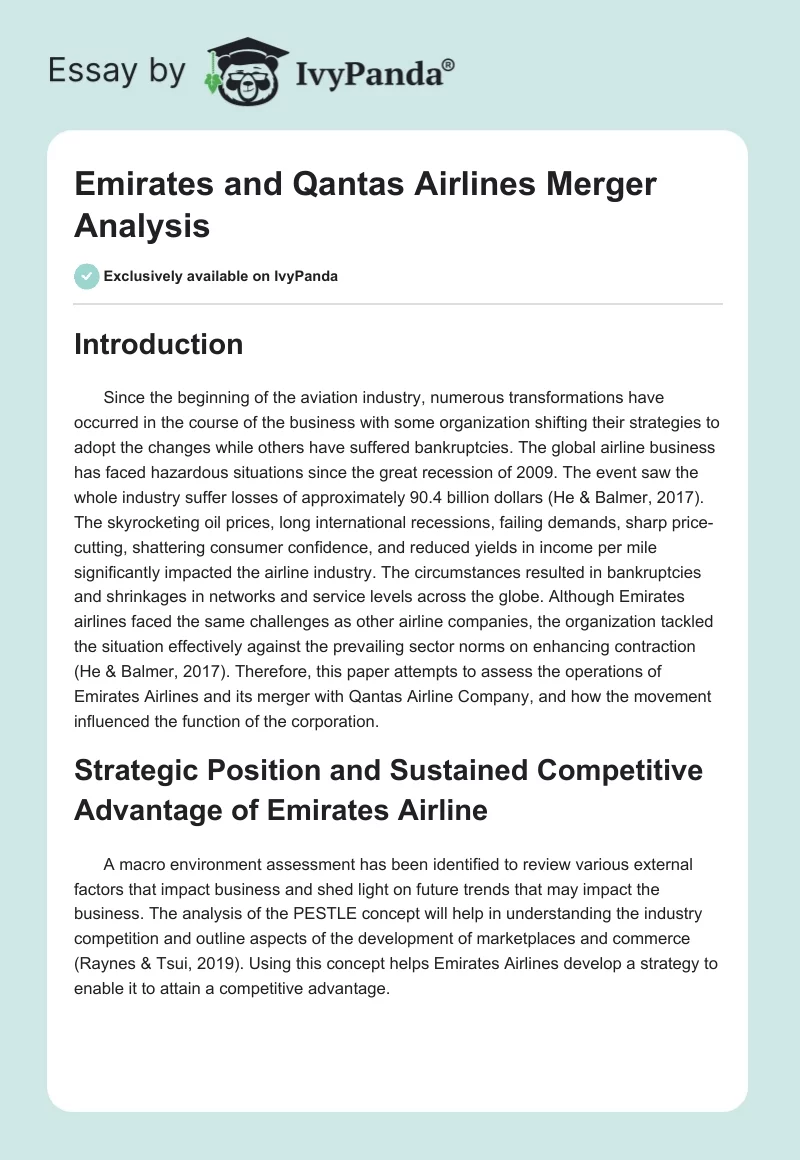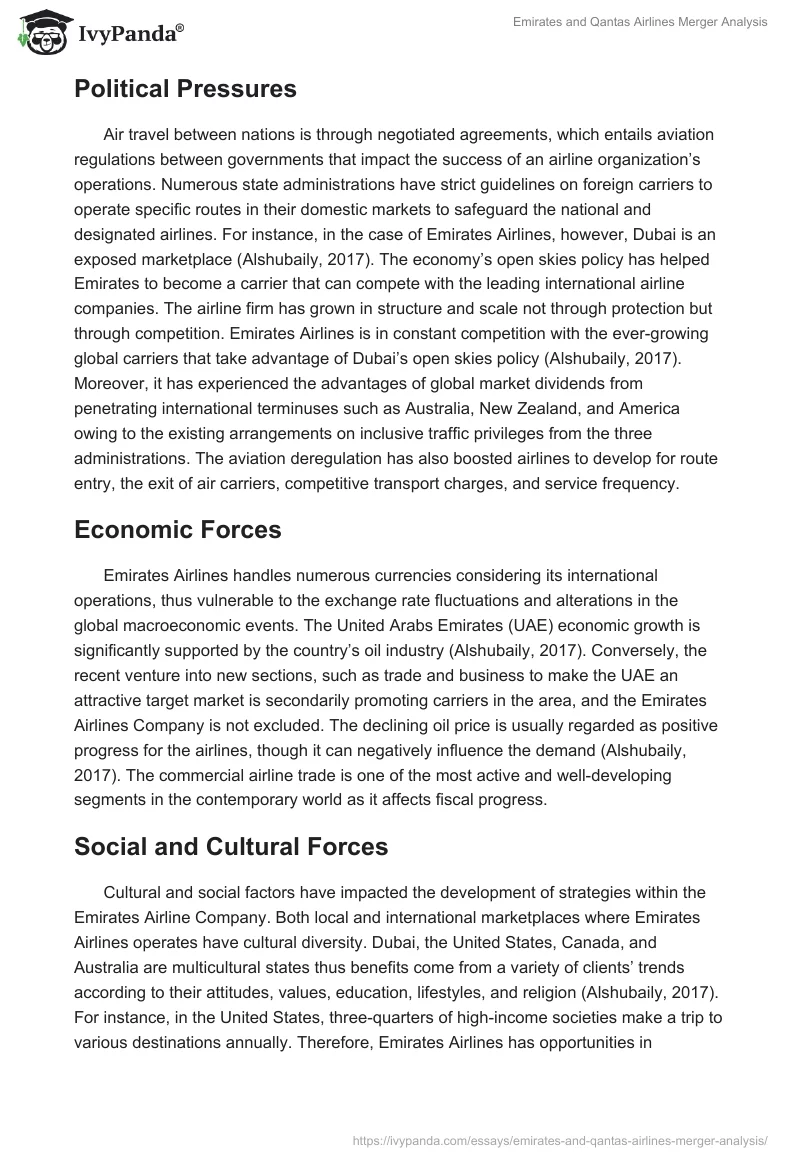Introduction
Since the beginning of the aviation industry, numerous transformations have occurred in the course of the business with some organization shifting their strategies to adopt the changes while others have suffered bankruptcies. The global airline business has faced hazardous situations since the Great Recession of 2009. The event saw the whole industry suffer losses of approximately 90.4 billion dollars (He & Balmer, 2017).
The skyrocketing oil prices, long international recessions, failing demands, sharp price-cutting, shattering consumer confidence, and reduced yields in income per mile significantly impacted the airline industry. The circumstances resulted in bankruptcies and shrinkages in networks and service levels across the globe.
Although Emirates Airlines faced the same challenges as other airline companies, the organization tackled the situation effectively against the prevailing sector norms on enhancing contraction (He & Balmer, 2017). Therefore, this paper attempts to assess the operations of Emirates Airlines and its merger with Qantas Airline Company, and how the movement influenced the function of the corporation.
Strategic Position and Sustained Competitive Advantage of Emirates Airline
A macro environment assessment has been identified to review various external factors that impact business and shed light on future trends that may impact the business. The analysis of the PESTLE concept will help in understanding the industry competition and outline aspects of the development of marketplaces and commerce (Raynes & Tsui, 2019). Using this concept helps Emirates Airlines develop a strategy to enable it to attain a competitive advantage.
Political Pressures
Air travel between nations is through negotiated agreements, which entails aviation regulations between governments that impact the success of an airline organization’s operations. Numerous state administrations have strict guidelines on foreign carriers to operate specific routes in their domestic markets to safeguard the national and designated airlines. For instance, in the case of Emirates Airlines, however, Dubai is an exposed marketplace (Alshubaily, 2017).
The economy’s open skies policy has helped Emirates to become a carrier that can compete with the leading international airline companies. The airline firm has grown in structure and scale not through protection but through competition. Emirates Airlines is in constant competition with the ever-growing global carriers that take advantage of Dubai’s open skies policy (Alshubaily, 2017).
Moreover, it has experienced the advantages of global market dividends from penetrating international terminuses such as Australia, New Zealand, and America owing to the existing arrangements on inclusive traffic privileges from the three administrations. The aviation deregulation has also boosted airlines to develop for route entry, the exit of air carriers, competitive transport charges, and service frequency.
Economic Forces
Emirates Airlines handles numerous currencies considering its international operations, thus vulnerable to the exchange rate fluctuations and alterations in the global macroeconomic events. The United Arabs Emirates’ (UAE) economic growth is significantly supported by the country’s oil industry (Alshubaily, 2017).
Conversely, the recent venture into new sections, such as trade and business to make the UAE an attractive target market is secondarily promoting carriers in the area, and the Emirates Airlines Company is not excluded. The declining oil price is usually regarded as positive progress for the airlines, though it can negatively influence the demand (Alshubaily, 2017). The commercial airline trade is one of the most active and well-developed segments in the contemporary world as it affects fiscal progress.
Social and Cultural Forces
Cultural and social factors have impacted the development of strategies within the Emirates Airline Company. Both local and international marketplaces where Emirates Airlines operates have cultural diversity. Dubai, the United States, Canada, and Australia are multicultural states thus benefits come from a variety of clients’ trends according to their attitudes, values, education, lifestyles, and religion (Alshubaily, 2017). For instance, in the United States, three-quarters of high-income societies make a trip to various destinations annually. Therefore, Emirates Airlines has opportunities in destinations where the trend of air travel is socially developed. Such has significantly influenced the company’s competitive advantage over other competitors in the industry.
Technological Forces
Modern technological innovations are a successful driver in the airline business. The demand for technological improvements to become the first motivator in the industry will develop the opportunity for attracting more of the lucrative commercial market. Emirates Airline’s management is aware of the principle of maintaining investments in the current technological innovations, thus pursuing its differentiation in the five-star standard airline. Emirates’ recent order book stands at 244 aircraft of the newest Airbus and Boeing, with an overall value of approximately 60 billion dollars (Göv, 2020).
Furthermore, the airline company aims to be a forerunner airline company in technological advancements. Emirates Airlines has signed an in-flight mobile phone coverage contract with the Aero Mobile Corporation, thus establishing the use of mobile phones onboard (Göv, 2020). Over a significant number of years, Emirates has gotten recognition from the international aviation websites as the leading flight company in entertainment and luxury due to its adoption of current technological innovations.
Environmental Forces
Since the environmental protection and safety of the passengers are part of the Emirates Airline Company’s mission objective, the company has been utilizing the low sulfur diesel as per the requirement of the state administration. The fuel has 10 parts per million (ppm) of sulfur which was further reduced to 500 ppm. The move has significantly helped the organization in addressing emissions.
The carrier also employs the Flex Track system, which is an air steering channel that enables it to overcome the auspicious weather. The initiative has aided in regulating 3800 tons of gas on a voyage to the Australian marketplace and 12000 tons of carbon dioxide emissions within a year (Göv, 2020). Therefore, the environmental sustainability approaches adopted by Emirates Airlines have further enabled it to gain a competitive edge in various markets despite their strict environmental laws.
Legal Forces
Legal limitations to satisfy distinct markets should be considered by the management of Emirates Airlines. State administrations have introduced restrictions on the airline companies to serve the travelers to minimize the competition from the domestic flights. For instance, the Chinese 1.3 billion population cannot be reached by airline unless the Chinese government opens its airspace to the carrier (Göv, 2020). Therefore, to realize the global demand, regulatory approval should be undertaken by the company.
Emirate’s Strategic Decision to Create Alliance with Qantas
The strategic alliance between the Emirate and Qantas Airline Companies saw the two companies move from the traditional alliance model to the competency framework. The partnership was aimed at delivering benefits to all divisions of the company. A conceptual framework is a concept that vastly defines performance excellence within a business ( Johnson, Whittington, Scholes, Angwin, & Regnér, 2017).
The framework normally comprises various competencies that are employed for numerous occupational responsibilities within a corporation. Furthermore, the framework is how companies communicate which behaviors are acceptable, required, valued, recognized, and rewarded relating to specific roles. For instance, considering threshold resources, the cabin crew and well-trained employees of the Airline Company have enabled it to effectively manage its operations and pacify clients.
The corporation has a practical and present fortified fleet of 265 airplanes with an estimated age of 4-6 years which is the pillar of the carrier’s competitive edge above the companies in the business (Johnson et al., 2017). Consequently, the threshold competencies that have propelled the company to its current market position is the advantage of terminal three which allows disturbance-free and prompt dealing of passenger traffic.
Choosing new routes and regularly pursuing new marketplaces and route decisions have helped in developing new streams of income for Emirates Airlines. However, the limitation of entry of new economies and threats requires 6 to 12 months of analysis to regulate the risks and achieve sustainable market conditions (Johnson et al., 2017). The competency framework, therefore, helps in improving the corporation’s threshold resources.
Conversely, the competency framework further helps in analyzing and understanding the Emirates Airline Company’s distinctive resources. The strategic decisions made by the company to partner with Qantas will enable the companies to boost the skills of their employees through training. For instance, the Emirates Airlines employee training college allows the Airline Corporation to equip its workers according to its employment requirements (Johnson et al., 2017).
The move to an ally will also help Qantas Carrier train its workforce thus boosting its competitive edge. Similarly, technological changes have resulted in the transformation of consumer experience, thus making it more personalized. Such an innovative shift has further improved operations which presently comprise robotics, biometrics, automation, and backing office functions.
Additionally, the zero accident policy and the management of crafts by the 85C checks undertaken annually are advantageous for the smooth running of both airline companies. The alliance was intended to improve realize environmentally friendly operations for both companies to boost their profitability. The focus on the environment through the employment of the Flex Track initiative and using ECO-thread technology for recyclable and environmentally responsive bottles reflect the sustainable operations of Emirates Airlines (Johnson et al., 2017).
The presence of availability of new aircraft, such as the Boeing 777 which are structured to provide luxury services to the consumer further makes the company distinct from its rival airline companies (Johnson et al., 2017). Therefore, the corporation’s strategic decision has played a vital role in ensuring the company remains competitive in the market and achieves a competitive edge in the aviation industry.
VRIO Analysis for Emirates and Qantas
VRIO Analysis for Emirates
VRIO Analysis of Qantas
According to the VRIO framework, it has been concluded that the biggest resources of the Emirates airline is its staff and technology that enables it to make the system function appropriately. The additional competencies are luxury experiences for the consumers, digital transformation, and environmentally friendly programs that develop a core competitive edge for the airline company (Zou & Chen, 2017).
On the other hand, from the VRIO outline for the Qantas airline, it can be observed that the company’s core resources are the technology and the luxury that enable it offer its clients the best experiences during their travel experiences. The organization’s other competencies include staff, environmentally friendly initiatives, entertainment which influence the firm’s functions (Zou & Chen, 2017). Therefore, the strengths of both Emirates and Qantas Airline Groups significantly rely of technology and luxury experiences, whereas their weaknesses are risks related to entering new marketplaces.
Conclusion
The Emirates justly deserves to be the leading airline in the aviation business. The company has been serving markets with high-class preferences, a factor that has influenced its success and competitive advantage in the industry. Furthermore, the airline company’s merger with Qantas has significantly impacted the organization’s achievement in entering new markets, such as the Australian market. However, the firm should avoid some of the vital aspects which resulted to the downfall of aviation echelons in the world. Its management should, therefore investigate the oil prices, financial mishandling, and the changing regulatory policies.
References
Alshubaily, A. (2017). Exploring the key success factors for young airlines. A focus on Emirates Airlines and its regional competitors’ strategy for success. Saudi Journal of Business and Management Studies, 2(1), 30–37.
Göv, S. A. (2020). Strategic Alliances in Airline Business: Comparison of Skyteam, Oneworld, Star Alliance Groups.Yönetim Bilimleri Dergisi, 18(38), 815–837. Web.
He, H.-W., & Balmer, J. M. (2017). Alliance brands: Building corporate brands through strategic alliances? In Advances in Corporate Branding (pp. 72–90). Springer.
Johnson, G., Whittington, R., Scholes, K., Angwin, D., & Regnér, P. (2017). Exploring strategy. Financial Times Prentice Hall.
Raynes, C., & Tsui, K. W. H. (2019). Review of Airline-within-Airline strategy: Case studies of the Singapore Airlines Group and Qantas Group.Case Studies on Transport Policy, 7(1), 150–165. Web.
Zou, L., & Chen, X. (2017). The effect of code-sharing alliances on airline profitability.Journal of Air Transport Management, 58, 50–57. Web.


